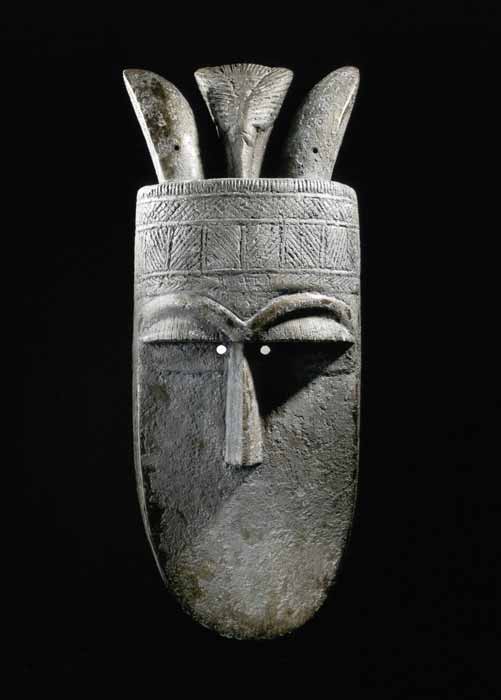Toma Wooden Nyangbai Mask, 20th Century CE
Wood
13.5 x 33.375
PF.3177
The Toma, known alternately as the Loma, are one of the numerous tribes of Mande-speaking people who descended from the northern savanna region into the forested band of west Africa...
The Toma, known alternately as the Loma, are one of the numerous tribes of Mande-speaking people who descended from the northern savanna region into the forested band of west Africa during the turbulent times of the later days of the Malian Empire (1230-1670). In recent times, the majority settled in the hilly rain forests of northern Liberia. Today, they number approximately two hundred thousand and are more or less equally divided between northern Liberia and southern Guinea (in Liberia, they are known as Loma while in Guinea the Mande form Toma is utilized). The Toma people practice shifting cultivation of upland rice that is suited to their high-altitude environment. They are patrilineal and their traditional political structures were based on village chiefdoms. The Toma are known for their long wooden masks that combine human and animal features. Nearly all masks were associated with the men’s society known as the Poro. This association was responsible for enforcing regulations regarding land use, initiation, marriage, and trade.
The largest type of Toma mask was over five feet tall with a long, movable, crocodile-toothed maul extending in front. The mid-section was composed of a human-like face with an exaggerated nose and forehead. The top section was crowned by a huge bunch of feathers of birds of prey stretching out at the back. For the Toma, as well as their neighbors the Bandi, this mask represented the major forest spirit (known as “Dandai” or “Landa”) that made manifest the power of the Poro. These masks were used during initiation ceremonies symbolically to devour boys in order to give them rebirth as men. While these huge masks are quite rare in collections, a relate type known as Nyangbai, representing the wife of the great forest spirit, are quite well known. These masks are smaller in dimension and feature a rounded forehead overhanging a large, flat facial plane. While some Toma masks were performed publicly, others, such as this type, would have only been seen by initiates. Toma masks are often striking for their stark simplicity of form, economy of line, and heavy sacrificial patina.
This Nyangbai mask is severely simplified as a flat plane overshadowed by the bulging forehead, from which the rectangular nose projects. This beautiful, dark colored mask is a fine example of the masks with horns, either cattle or antelope, sculpted in a minimal manner. The eye holes on either side of the nose shows that the mask was intended to be placed directly over the face of the male dancer. The contour lines of the mask are simple and elegant, and there is no indication of mouth and little suggestion of eyes besides the prominent brow and bulging lids. Perhaps rendition of a mouth was not considered necessary, since the mask represented spirits and only eyes were used to see the supernatural world of spirits. The large horns add dramatic affects to this already powerful mask. Rituals and ceremonies in which this large, almost abstract mask was used must have been powerful and enchanting. It is believed that such masks, representing the female forces of nature, played a subordinate role to the larger male masks during initiation ceremonies or important funerals. Undoubtedly, such power still remains with the mask, capturing our eyes and attention.
The largest type of Toma mask was over five feet tall with a long, movable, crocodile-toothed maul extending in front. The mid-section was composed of a human-like face with an exaggerated nose and forehead. The top section was crowned by a huge bunch of feathers of birds of prey stretching out at the back. For the Toma, as well as their neighbors the Bandi, this mask represented the major forest spirit (known as “Dandai” or “Landa”) that made manifest the power of the Poro. These masks were used during initiation ceremonies symbolically to devour boys in order to give them rebirth as men. While these huge masks are quite rare in collections, a relate type known as Nyangbai, representing the wife of the great forest spirit, are quite well known. These masks are smaller in dimension and feature a rounded forehead overhanging a large, flat facial plane. While some Toma masks were performed publicly, others, such as this type, would have only been seen by initiates. Toma masks are often striking for their stark simplicity of form, economy of line, and heavy sacrificial patina.
This Nyangbai mask is severely simplified as a flat plane overshadowed by the bulging forehead, from which the rectangular nose projects. This beautiful, dark colored mask is a fine example of the masks with horns, either cattle or antelope, sculpted in a minimal manner. The eye holes on either side of the nose shows that the mask was intended to be placed directly over the face of the male dancer. The contour lines of the mask are simple and elegant, and there is no indication of mouth and little suggestion of eyes besides the prominent brow and bulging lids. Perhaps rendition of a mouth was not considered necessary, since the mask represented spirits and only eyes were used to see the supernatural world of spirits. The large horns add dramatic affects to this already powerful mask. Rituals and ceremonies in which this large, almost abstract mask was used must have been powerful and enchanting. It is believed that such masks, representing the female forces of nature, played a subordinate role to the larger male masks during initiation ceremonies or important funerals. Undoubtedly, such power still remains with the mask, capturing our eyes and attention.
Literature
V19



